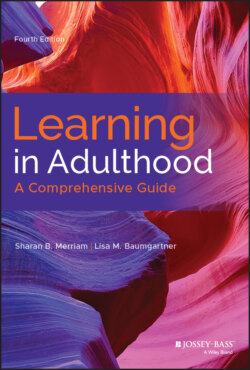Читать книгу Learning in Adulthood - Sharan B. Merriam - Страница 53
Participation Is a Good Thing
ОглавлениеStudies of participation assume that everyone should want to engage in adult education because it is a good thing to do. Underlying many of the stated purposes of adult education in the United States is the assumption that the ideal of a democratic society must be maintained and that education is one way to do this. Individualism, independence, and a Protestant-capitalist work ethic frame the actual provision of adult education in America. Further, because this is a democratic society, all individuals have access and the opportunity to benefit from education. As Lindeman (1926/1989) proposed early in the founding of the field, adult education had a dual purpose of improving both society and the individual. In practice, however, a case can be made that education is “an agent of social control” (Torres, 2013, p. 9) rather than empowerment and that adult education in the United States is elitist and exclusionary. As evidence of adult education's elite bias, Cunningham (1988, p. 133) points to middle-class participation patterns, the homogeneous, technically oriented training of adult educators, the “psychology of individual deficit” that serves as a basis for explaining social inequities, and the erosion of the voluntary nature of adult education.
Most societies in fact use education to preserve the status quo rather than to bring about change or address inequities. In reviewing the common functions of adult education, Jarvis (1985/2012) points out how they can be used in the service of maintaining the status quo. Adult education maintains the social system and existing social relations because “people have internalized that culture in previous learning experiences, even when they act alone, they do so from the perspective of their social history. Hence, they are actually acting within a social context” (Jarvis, 1985/2012, p.134). Individual advancement and selection, although appearing to develop individuals, is actually a selective process carefully monitored by the system itself. Another function—offering a second chance and legitimization—also promotes the dominant culture because “second chance education actually produces an appearance of greater equality of opportunity and, hence, reinforces the existing social structures” (Jarvis, 1985/2012, p. 143). Even leisure-time pursuits have as a latent function “the retention of stability in the social system at a time when many people do not have work to occupy their time and their minds” (Jarvis, 1985/2012, p. 147). Finally, development and liberation can be goals of adult education, although one should be aware that such development and liberation may actually be designed to enable people to fit more easily into the existing social system.
The problems to which adult educators respond tend to be identified by those who have a value perspective not necessarily shared by the target population. As Cunningham (1988, p. 141) has noted, much program planning is based on an individual deficit model rather than an examination of “the oppressive structures in which people live.” Programs are thus designed around learner deficiencies that may or may not be of concern to the learner. What is necessary, Cunningham and others assert, is for socially responsible adult educators to become aware of the “social as well as personal dimensions of learning and the capacity of education to respond” (Cunningham, 2000, p. 574). Cunningham goes on to point out that “if one conceptualized any nation as composed of the state (governmental sector), civil society (voluntary sector), and the market (economic sector), then how these sectors are related and how education serves these sectors become critical questions in understanding the relationships between adult education and society” (p. 574).
Nevertheless, “adult education is given public support when the public can see the connection between education and the solution to a threatening situation” (Griffith & Fujita-Starck, 1989, p. 172). Most “threatening” are challenges to economic stability and social order. However, the emphasis may shift with changes in society's social, cultural, and economic structures. Literacy education in colonial America was invested in for a greater religious purpose; this gave way to a citizenship orientation in the wake of independence during the mid-eighteenth century, which in turn was eclipsed by vocational training and immigrant education at the turn of the twentieth century. Torres (2013) points out that we are undergoing a further shift in moving away from the notion of adult education to the concept of lifelong learning. This is a positive shift in that the focus moves “from teacher to learner, and from formal to nonformal and informal learning experiences, within and outside of educational institutions, within the workplace and given the virtuality of the new cybernetic culture, virtually everywhere” (p. 9). The concept of lifelong learning, Torres feels, is a better concept to address today's “challenges to immigration, multiculturalism and affirmative action” (p. 9).
In light of the social forces documented in Chapter 1—demographics, economics, and technology—the purposes of adult education today for which there is public support cluster around the United States sustaining a competitive edge in a global economy. This translates into preparing and then maintaining an informed and efficient workforce. Along with this economic imperative is the assumption that social stability is both a product and a goal of adult education and training. Thousands of restless, illiterate, unemployed, or underemployed adults pose a threat to the stability of the social order, not to mention a drain on social resources. So although the rhetoric of adult education suggests some rather lofty ideals for the purpose of the endeavor, the reality suggests a more conservative purpose: maintenance of the status quo, which today means a capitalist economic system that values individuality, independence, and entrepreneurialism. Thus we see a growing emphasis on human resource development and training, continued provision for basic skill acquisition, and ever-expanding postsecondary opportunities for adults.
